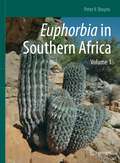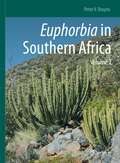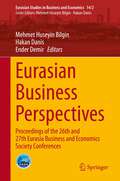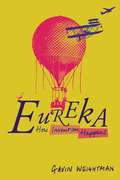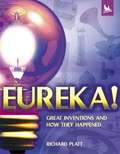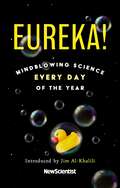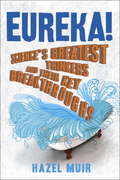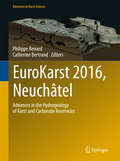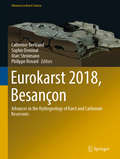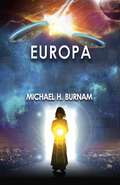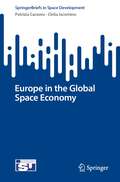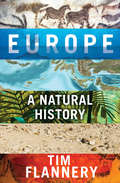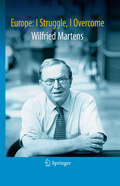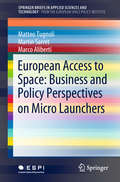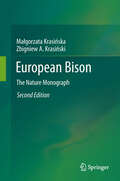- Table View
- List View
Euphorbia in Southern Africa: Volume 1
by Peter V. BruynsThis book presents a new account of Euphorbia in southern Africa. Euphorbia is the second largest genus of plants in the world. Southern Africa enjoys a high diversity in Euphorbia and 170 species occur here naturally. Of these 170 species, 128 or 74% are endemic. Where most species of Euphorbia in the northern hemisphere are herbs or shrubs, most of those in southern African are succulent. These succulents range from small, almost geophytic forms where the tuber is larger than the above-ground parts to huge trees 6 to 15 m or more in height. Many of them are spiny. There are also small numbers of herbaceous species in southern Africa and many of these are also dealt with here. The last account of the succulent species for southern Africa was published in 1941 and much new data has accumulated since then. Our understanding of the relationships of the species in Euphorbia has also been greatly enhanced by recent analyses of DNA-data, which led to new and unexpected results. From this new information an entirely new classification was developed, in which Euphorbia was divided into four subgenera. This provides the taxonomic framework for the presentation of our species here. Around ten new species have been described and these are presented in detail for the first time. This monograph is made up of two volumes. Volume 1 contains an extensive introductory chapter with an overview of the genus in the region, emphasizing many of its important and distinctive features. This is followed by Chapter 2, which deals with subgenus Athymalus. Of the four subgenera, this one is by far the most diverse in southern Africa, with 80 species. Volume 2 contains Chapters 3 (subg. Chamaesyce, 34 species), 4 (subg. Esula, 11 species) and 5 (subg. Euphorbia, 45 species), as well as an additional Chapter 6 covering the remarkable diversity of subg. Euphorbia in Moçambique. Each of Chapters 2 to 5 includes a key to all the species, followed by an account of each of them. This account includes synonymy, a description, data on distribution and habitat, line-drawings of floral features and other diagnostic details, notes on how the species is distinguished from its closest relatives and a brief history of its discovery. Several colour photographs are included for each species, illustrating its habitat, vegetative habit and flowering features, demonstrating key points distinguishing it from others and often showing its variability. Euphorbia is an important component of the vegetation in many of the drier parts of southern Africa. This book is based on a thorough evaluation of the vast herbarium record for southern African members of Euphorbia, on the extensive field-work conducted in the region and the wide taxonomic experience of the author. It is believed that both the professional botanist and the layman will find much that is new and informative in this monograph.
Euphorbia in Southern Africa: Volume 2
by Peter V. BruynsThis book presents a new account of Euphorbia in southern Africa. Euphorbia is the second largest genus of plants in the world. Southern Africa enjoys a high diversity in Euphorbia and 170 species occur here naturally. Of these 170 species, 128 or 74% are endemic. Where most species of Euphorbia in the northern hemisphere are herbs or shrubs, most of those in southern African are succulent. These succulents range from small, almost geophytic forms where the tuber is larger than the above-ground parts to huge trees 6 to 15 m or more in height. Many of them are spiny. There are also small numbers of herbaceous species in southern Africa and many of these are also dealt with here. The last account of the succulent species for southern Africa was published in 1941 and much new data has accumulated since then. Our understanding of the relationships of the species in Euphorbia has also been greatly enhanced by recent analyses of DNA-data, which led to new and unexpected results. From this new information an entirely new classification was developed, in which Euphorbiawas divided into four subgenera. This provides the taxonomic framework for the presentation of our species here. Around ten new species have been described and these are presented in detail for the first time.This monograph is made up of two volumes. Volume 1 contains an extensive introductory chapter with an overview of the genus in the region, emphasizing many of its important and distinctive features. This is followed by Chapter 2, which deals with subgenus Athymalus. Of the four subgenera, this one is by far the most diverse in southern Africa, with 80 species. Volume 2 contains Chapters 3 (subg. Chamaesyce, 34 species), 4 (subg. Esula, 11 species) and 5 (subg. Euphorbia, 45 species), as well as an additional Chapter 6 covering the remarkable diversity of subg. Euphorbia in Moçambique. Each of Chapters 2 to 5 includes a key to all the species, followed by an account of each of them. This account includes synonymy, a description, data on distribution and habitat, line-drawings of floral features and other diagnostic details, notes on how the species is distinguished from its closest relatives and a brief history of its discovery. Several colour photographs are included for each species, illustrating its habitat, vegetative habit and flowering features, demonstrating key points distinguishing it from others and often showing its variability.Euphorbia is an important component of the vegetation in many of the drier parts of southern Africa. This book is based on a thorough evaluation of the vast herbarium record for southern African members of Euphorbia, on the extensive field-work conducted in the region and the wide taxonomic experience of the author. It is believed that both the professional botanist and the layman will find much that is new and informative in this monograph.
Eurasian Arctic Land Cover and Land Use in a Changing Climate
by Garik Gutman Anni ReissellThis volume is a compilation of studies on interactions of land-cover/land-use change with climate in a region where the climate warming is most pronounced compared to other areas of the globe. The climate warming in the far North, and in the Arctic region of Northern Eurasia in particular, affects both the landscape and human activities, and hence human dimensions are an important aspect of the topic. Environmental pollution together with climate warming may produce irreversible damages to the current Arctic ecosystems. Regional land-atmosphere feedbacks may have large global importance. Remote sensing is a primary tool in studying vast northern territories where in situ observations are sporadic. State-of-the-art methods of satellite remote sensing combined with GIS and models are used to tackle science questions and provide an outlook of current land-cover changes and potential scenarios for the future. Audience: The book is a truly international effort involving U.S. and European scientists. It is directed at the broad science community including graduate students, academics and other professionals in this field.
Eurasian Business Perspectives: Proceedings of the 26th and 27th Eurasia Business and Economics Society Conferences (Eurasian Studies in Business and Economics #14/2)
by Mehmet Huseyin Bilgin Hakan Danis Ender DemirThis book presents selected theoretical and empirical papers from the 26th and 27th Eurasia Business and Economics Society (EBES) Conferences, held in Prague, Czech Republic, and Bali, Indonesia. Covering diverse areas of business and management in various geographic regions, it addresses a range of current topics, such as human resources, management, SMEs and marketing. It also includes related studies that analyze management and marketing aspects, e.g. workplace learning, gamification in business, resilience and entrepreneurship, the use of IT tools in small businesses, and dynamic marketing capabilities in an intercultural environment.
Eurasian Steppes. Ecological Problems and Livelihoods in a Changing World
by Marinus J.A. Werger Marja A. van StaalduinenSteppes form one of the largest biomes. Drastic changes in steppe ecology, land use and livelihoods came with the emergence, and again with the collapse, of communist states. Excessive ploughing and vast influx of people into the steppe zone led to a strong decline in nomadic pastoralism in the Soviet Union and China and in severely degraded steppe ecosystems. In Mongolia nomadic pastoralism persisted, but steppes degraded because of strongly increased livestock loads. After the Soviet collapse steppes regenerated on huge tracts of fallow land. Presently, new, restorative steppe land management schemes are applied. On top of all these changes come strong effects of climate change in the northern part of the steppe zone. This book gives an up-to-date overview of changes in ecology, climate and use of the entire Eurasian steppe area and their effects on livelihoods of steppe people. It integrates knowledge that so far was available only in a spectrum of locally used languages.
Eureka
by Gavin WeightmanTracing the long pre-history of five twentieth-century inventions which have transformed our lives, Gavin Weightman reveals a fantastic cast of scientists and inspired amateurs whose ingenuity has given us the airplane, television, bar code, personal computer, and mobile phone. Not one of these inventions can be attributed to a lone genius who experiences a moment of inspiration. Nearly all innovations exist in the imagination before they are finally made to work by the hard graft of inventors who draw on the discoveries of others. While the discoveries of scientists have provided vital knowledge which has made innovation possible, it is a revelation of Weightman's study that it is more often than not the amateur who enjoys the "eureka moment" when an invention works for the first time. Filled with fascinating stories of struggle, rivalry, and the ingenuity of both famous inventors and hundreds of forgotten people, Weightman's captivating work is a triumph of storytelling that offers a fresh take on the making of our modern world. "
Eureka! Great Inventions and How They Happened
by Richard PlattEureka! Looks at the instances in which some of the world's greatest inventions were conceived and explains how creative genius has enabled some individuals to look right through a problem and come up with a solution that has eluded rivals. From the excitement of Newton's historic discovery of the laws of gravity to the more recent creation of Teflon, this fascinating book illuminates an amazing variety of inventions, as well as the moments of inspiration (and sometimes perspiration) behind them.
Eureka! It's an Airplane!
by Jeanne BendickUncovers the chain of discoveries--dating back to the ancient Greeks and including the contributions of the Wright brothers--that led to the invention of the modern airplane.
Eureka!: 50 Scientists Who Shaped Human History
by John GrantGalileo, Einstein, Curie, Darwin, Hawking — we know the names, but how much do we really know about these people? Galileo gained notoriety from his battle with the Vatican over the question of heliocentrism, but did you know that he was also an accomplished lute player? And Darwin of course discovered the principle by which new species are formed, but his bold curiosity extended to the dinner table as well. (And how many people can say they've eaten an owl!) In Eureka! John Grant — author of Debunk It!, Discarded Science, Spooky Science and many others — offers fifty vivid portraits of groundbreaking scientists, focusing not just on the ideas and breakthroughs that made them so important but also on their lives and their various...quirks.
Eureka!: Mindblowing Science Every Day of the Year
by New ScientistIntroduced by Jim Al-KhaliliCould you surf down an erupting volcano?Why do zebras have stripes?Are you breathing the same air as Leonardo da Vinci?Are there any green mammals?Why do pineapples have spikes?Why do songs get stuck in your head?What happens when black holes collide?Can you extract your DNA?New Scientist has been a treasure trove of fascinating and surprising questions and answers for over a decade. From how to measure the speed of light using chocolate, to why dogs howl at sirens, Eureka! brings together 365 mindblowing questions, fascinating facts and exciting experiments.If you've ever wondered how to escape quicksand, what would happen if the moon vanished, and why cats (nearly) always land on their feet, you've come to the right place.
Eureka!: Mindblowing Science Every Day of the Year
by New ScientistIntroduced by Jim Al-KhaliliCould you surf down an erupting volcano?Why do zebras have stripes?Are you breathing the same air as Leonardo da Vinci?Are there any green mammals?Why do pineapples have spikes?Why do songs get stuck in your head?What happens when black holes collide?Can you extract your DNA?New Scientist has been a treasure trove of fascinating and surprising questions and answers for over a decade. From how to measure the speed of light using chocolate, to why dogs howl at sirens, Eureka! brings together 365 mindblowing questions, fascinating facts and exciting experiments.If you've ever wondered how to escape quicksand, what would happen if the moon vanished, and why cats (nearly) always land on their feet, you've come to the right place.
Eureka!: Science's Greatest Thinkers and Their Key Breakthroughs
by Hazel MuirFrom Aristotle's pioneering research into animal biology to Harvey's theory of the circulation of the blood; from Copernicus's theory of the heliocentric universe to Carl Sagan's speculations on extraterrestrial life; and from Einstein's theory of Relativity to Heisenberg's uncertainty principle, Eureka! condenses the essential biographies and principal discoveries of the world's most important scientistsinto 300 bite-sized entries. Spanning the full spectrum of scientific disciplines - including physics, biology, earth science, cosmology, chemistry, archaeology and behavioural science - this book is the perfect introduction to the pioneering work of scientists throughout the ages.
Eureka: Discovering Your Inner Scientist
by Chad OrzelEven in the twenty-first century the popular image of a scientist is a reclusive genius in a lab coat, mixing formulas or working out equations inaccessible to all but the initiated few. The idea that scientists are somehow smarter than the rest of us is a common, yet dangerous, misconception, getting us off the hook for not knowing#151;or caring#151;how the world works. How did science become so divorced from our everyday experience? Is scientific understanding so far out of reach for the non-scientists among us? As science popularizer Chad Orzel argues in Eureka, even the people who are most forthright about hating science are doing science, often without even knowing it. Orzel shows that science isn’t something alien and inscrutable beyond the capabilities of ordinary people, it’s central to the human experience. Every human can think like a scientist, and regularly does so in the course of everyday activities. The disconnect between this reality and most people’s perception is mostly due to the common misconception that science is a body of (boring, abstract, often mathematical) facts. In truth, science is best thought of as a process: Looking at the world, Thinking about what makes it work, Testing your mental model by comparing it to reality, and Telling others about your results. The facts that we too often think of as the whole of science are merely the product of this scientific process. Eureka shows that this process is one we all regularly use, and something that everybody can do. By revealing the connection between the everyday activities that people do#151;solving crossword puzzles, playing sports, or even watching mystery shows on television#151;and the processes used to make great scientific discoveries, Orzel shows that if we recognize the process of doing science as something familiar, we will be better able to appreciate scientific discoveries, and use scientific facts and thinking to help address the problems that affect us all.
EuroKarst 2016, Neuchâtel
by Catherine Bertrand Philippe RenardThis book presents the latest advances in the field of karst hydrogeology and carbonate reservoirs. These include, but are not limited to: geomorphology of karst, flow and solute transport in karst; innovative metrology; modelling; speleogenesis and geology of carbonate reservoirs; deep reservoir exploration and production; water management and protection in karst environments; contaminant migration and chemical behavior; hydrochemistry and regional aquifer studies. EuroKarst offers a platform for professional exchanges between field practitioners and academic researchers. It is the European biennial conference on the hydrogeology of karst and carbonate reservoirs. It is organized every two years by the Universities of Neuchâtel (Switzerland), Besançon (France), and Malaga (Spain).
Eurocentrism and the Politics of Global History
by Alessandro StanzianiGlobal history locates national histories in the context of broader processes, in which the West is not necessarily synonymous with progress. And yet it often suffers from the same Eurocentrism that plagues national history, accepting Western categories and values uncritically and largely ignoring non-English historiographies. Alessandro Stanziani examines these tensions and asks what global history is and ought to be. Drawing upon a wide array of sources, he historicizes global history writing from the sixteenth century onward, tracing the forces of revolution, globalization, totalitarianism, colonization, decolonization and the Cold War. By considering global history in the context of a longue durée, multipolar perspective, this book assesses the strengths and limits of the field, and clarifies what is at stake.
Eurokarst 2018, Besançon: Advances in the Hydrogeology of Karst and Carbonate Reservoirs (Advances in Karst Science)
by Catherine Bertrand Philippe Renard Sophie Denimal Marc SteinmannThis book presents selected papers from the EuroKarst 2018 conference, which highlighted the latest advances in the field of Karst Hydrogeology and Carbonate Reservoirs. The event attracted more than 180 participants. From among their contributions, the papers were selected and subsequently reviewed by the scientific committee to ensure the highest possible quality.
Europa: Book Three of The Last Stop Trilogy
by Michael H. BurnamTwo hundred thousand years on from when the humanoid Europans were ruled by tyrannical religious group, the Sect, in an undersea city, Earth becomes the battleground as Europa&’s sentient robots and the Sect&’s descendants collide in the final battle of their eons&’ long war. 'Europa is the page-turning finish to The Last Stop Trilogy. Central to the story is a deep existential dilemma: facing annihilation, would you chose to download your conscious into a computer to survive? After achieving immortality, would you give it up to become humanoid again? Burnam weaves this theme into a heart-warming, intergalactic love story where the action never stops.' Robert D. Zanger, Founder and of the Albert Hoffman Foundation for Consciousness Research. The third and final instalment of The Last Stop Trilogy.
Europe in the Global Space Economy (SpringerBriefs in Space Development)
by Clelia Iacomino Patrizia CaraveoThis book analyzes the policies and space economy programs of major space-faring nations and explores whether the present institutional set-up in Europe is adequate to address the challenges. At the core of the discussion are the relative roles of governments and markets in a highly dynamic panorama that involves advancements in science, modifications in technology and organization, and the introduction of new rules of behavior. After a close examination of the history of development of the space economy, and the shift from the centralized model to deregulation and the opening up of space activities to commercial companies, a wide-ranging overview of global space governance is provided. National and regional perspectives are discussed, and the current role of commercial actors in the global space system is elucidated. The various challenges faced by Europe are then examined, including the threat posed by institutional and market fragmentation to the emergence of European companies able to compete with companies of nations such as the USA. The final part of the book analyzes proposals for reforming of the space system in Europe and offers a vision for future European space policy.
Europe's Role in Nation-Building: From the Balkans to the Congo
by James Dobbins Keith Crane Seth G. Jones Christopher S. Chivvis Andrew RadinTwo previous RAND volumes addressed the roles of the United States and the United Nations in nation-building, defined as the use of armed force in the aftermath of a conflict to promote a durable peace and representative government. This volume presents six case studies of recent European-led nation-building missions: Albania, Sierra Leone, Macedonia, Cote d'Ivoire, the Democratic Republic of the Congo, and Bosnia. It also reviews the Australian assistance mission to the Solomon Islands. Using quantitative and qualitative measures to compare inputs (such military levels, economic assistance and duration) and outcomes (such as levels of security, economic growth, refugee return, and democracy), the analysis concludes that these European-led missions have been competently managed and, within their sometimes quite limited scope, generally successful. Most helped achieve sustained peace, gross domestic product growth, and representative government. The EU has a wide array of civil competencies for nation-building, but it is sometimes slow to deploy them in support of its military operations, particularly when these are conducted far from Europe. The UN offers the most cost-effective means to address most postconflict stabilization requirements and NATO the better framework for large-scale force projection in cases in which the United States is ready to participate. But the EU now offers European governments a viable alternative to both these organizations in cases in which European interests are high, U.S. interests are low, and the UN is, for some reason, unsuitable or unavailable.
Europe: A Natural History
by Tim FlanneryA tale of cave bears and comet strikes and a hundred million years of history by the bestselling author of Here on Earth: &“Marvelous.&”—Publishers Weekly (starred review) In Europe: A Natural History, world-renowned scientist, explorer, and conservationist Tim Flannery applies the eloquent interdisciplinary approach he used in his ecological histories of Australia and North America to the story of Europe. He begins 100 million years ago, when the continents of Asia, North America, and Africa interacted to create an island archipelago that would later become the Europe we know today. It was on these ancient tropical lands that the first distinctly European organisms evolved. Flannery teaches us about Europe&’s midwife toad, which has endured since the continent&’s beginning, while elephants, crocodiles, and giant sharks have come and gone. He explores the monumental changes wrought by the devastating comet strike and shows how rapid atmospheric shifts transformed the European archipelago into a single landmass during the Eocene. As the story moves through millions of years of evolutionary history, Flannery eventually turns to our own species, describing the immense impact humans had on the continent&’s flora and fauna—within 30,000 years of our arrival in Europe, the woolly rhino, the cave bear, and the giant elk, among others, would disappear completely. The story continues right up to the present, as Flannery describes Europe&’s leading role in wildlife restoration, and then looks ahead to ponder the continent&’s future: with advancements in gene editing technology, European scientists are working to recreate some of the continent&’s lost creatures, such as the great ox of Europe&’s primeval forests and even the woolly mammoth.
Europe: I Struggle, I Overcome
by Wilfried MartensWilfried Martens - Europe: I Struggle, I Overcome Foreword by Angela Merkel Wilfried Martens has devoted his entire life to politics: as student leader, youth activist, President of the Flemish Christian Democrats, Prime Minister of Belgium, President of the European People's Party and European statesman. In his autobiography Martens offers the inside story on running a complex country like Belgium, fighting for European integration and unification, and transforming the European People's Party into a strong, united centre-right movement and leading European political family. Above all, this is a book about the intricacies of European politics and its guiding ideas, values and principles.
European Access to Space: Business and Policy Perspectives on Micro Launchers (SpringerBriefs in Applied Sciences and Technology)
by Marco Aliberti Matteo Tugnoli Martin SarretThe book provides an analysis of the dynamics of the global launch service market associated with small satellites, by placing a particular focus on its unfolding trends and future outlook.From an economic perspective, the emergence of numerous micro launcher initiatives on top of already existing launch solutions for small satellites raises questions about the specific nature and size of the small satellite market that will - or could - be addressed by these emerging launch services offerings. Identifying the specific features of such market by characterizing customers' expectations and providing a competitive analysis of the different launch solutions for small satellites is the second objective of this report.Finally, and from a policy perspective, the book reflects on whether such market could and should be handled on a purely private basis in the European context, or on the contrary generates relevant stakes that compels European institutional actors to become more actively involved in this domain.
European Bison
by Małgorzata Krasińska Zbigniew A. KrasińskiThe mighty and majestic European bison is the relictual embodiment of the wildness of prehistoric Europe. Tragically, the millennia since that time have seen so many species driven to extinction by human impacts, and the European bison has only narrowly avoided the same fate. Today, the species represents the symbolic sentinel of successful conservation actions in a world in which such achievements remain few and far between. From an early stage in the restitution of the European bison, husband-and-wife team Małgorzata Krasińska and Zbigniew A. Krasiński have been participating in relevant management initiatives and researching all facets of the bison, from its morphology and diet, to its movements, social life and reproduction, and the conservation management actions that have been taken to save it. Now they have summarised this wealth of knowledge on the species, giving rise to a publication ideal for students, professional biologists and conservationists, but also for all nature enthusiasts. This new edition of the monograph offers extensively updated content taking into account research carried out on the European bison in the last few years. Also featured, a new chapter devoted to knowledge of the genetics of the species drawn up by Małgorzata Tokarska of the Białowieża-based Mammal Research Institute PAS.
European Communities' Health and Safety Legislation
by A.C. Neal F.B. WrightThis important new book presents the background to the modern programme of European Community initiatives, tracing the origins of a European policy on occupational health and safety, and looking at the progressively expanding ambitions of Commission Action Programmes in this field.
